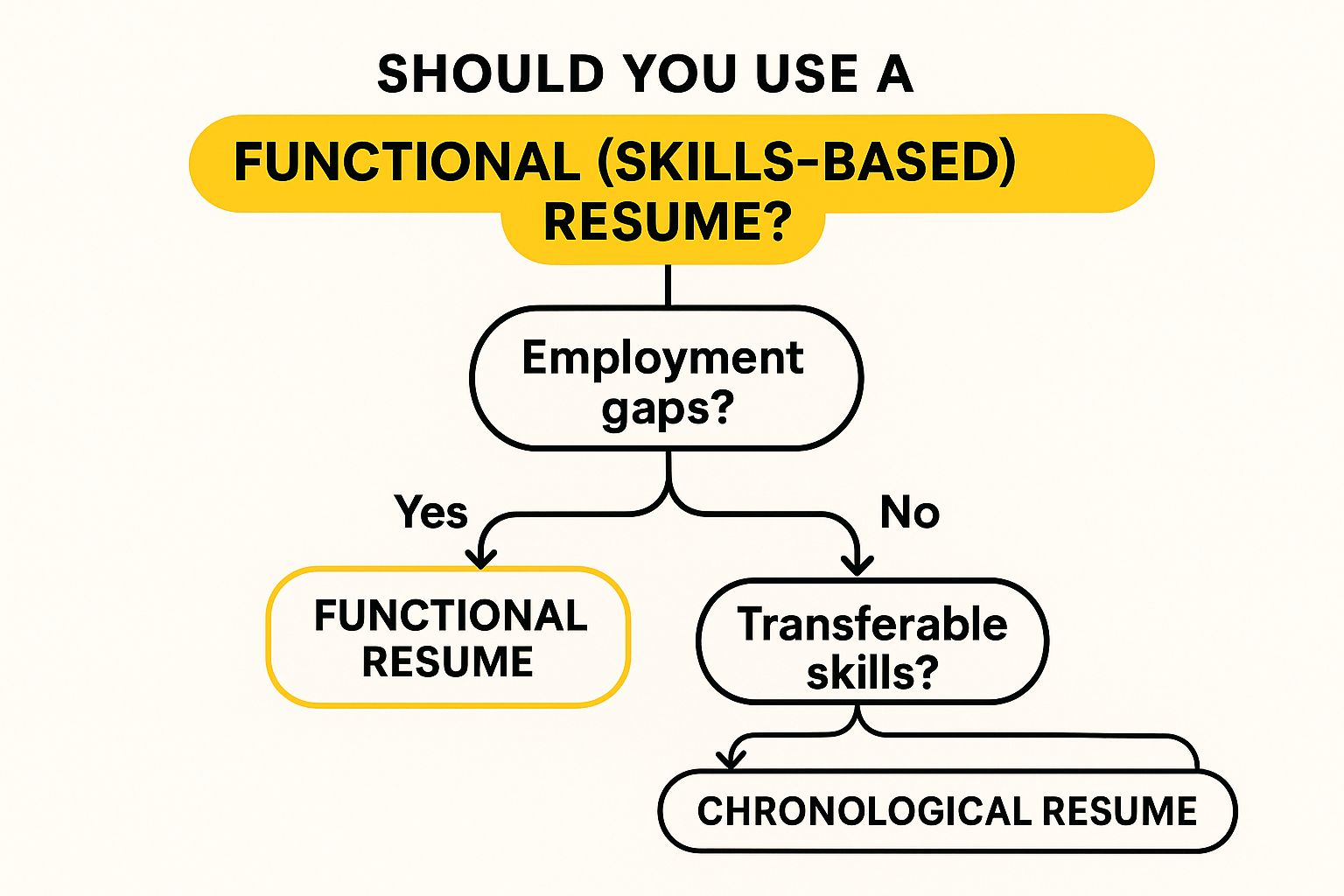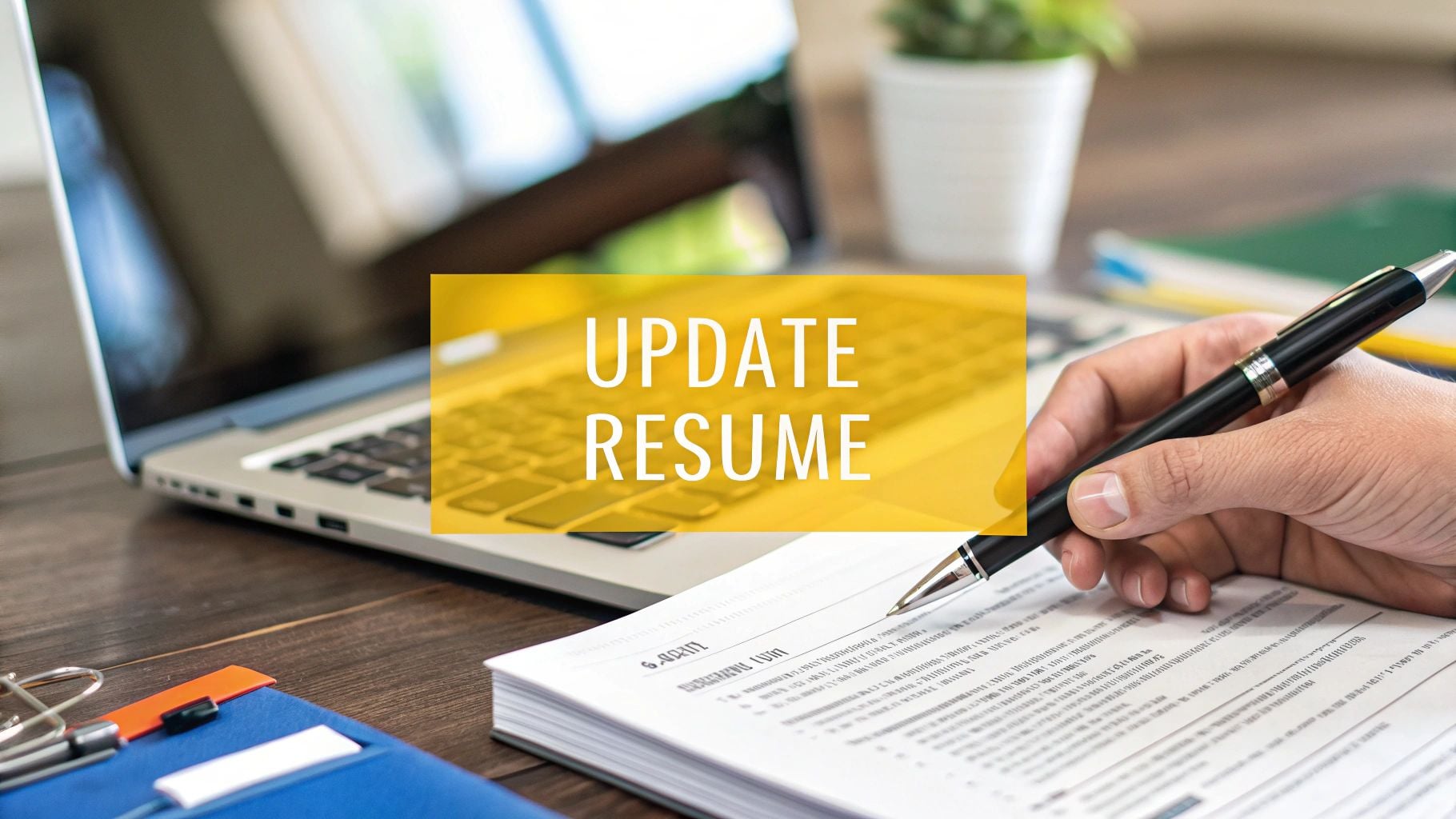Making a career change can be one of the most exciting and challenging decisions in your professional life. Your resume is your primary tool for this transition, but a standard chronological format often fails to tell your story effectively. A career change resume needs to do more than list past jobs; it must build a compelling bridge between where you've been and where you want to go. This involves strategically highlighting transferable skills, reframing achievements, and demonstrating your potential in a new context.
This article provides a detailed breakdown of eight distinct career change resume examples, each designed for a specific pivot scenario. We will analyze the strategy behind each format, from a functional skills-based layout to a combination resume that blends experience with potential. For each example, you will find actionable takeaways and specific tactics to help you reframe your own professional narrative. The goal is to equip you with the tools to prove you are the right candidate, even with a non-traditional background.
A polished presentation is also key to making a strong first impression. Just as you tailor your resume content, ensure your professional headshot reflects the new role you're aiming for. Many professionals are now using AI-generated headshots to create studio-quality images affordably, ensuring their visual brand aligns with their career aspirations.
1. Functional (Skills-Based) Resume: Highlighting What You Can Do, Not Just Where You've Been
The functional resume format strategically shifts the focus from a chronological work history to your core competencies. This approach is one of the most effective career change resume examples because it immediately showcases what you can do for a potential employer, rather than highlighting potentially unrelated past job titles. It's designed to downplay non-linear career paths or gaps in employment.
Instead of listing jobs and duties, you group your experiences into relevant skill categories such as "Project Management," "Digital Marketing," or "Client Relationship Management." Under each category, you list bulleted achievements that provide concrete proof of your expertise. This structure allows a hiring manager to quickly see your value, even if your previous role was in a completely different industry.
Strategic Breakdown
- When to Use It: Ideal for significant career pivots, re-entering the workforce after a break, or when your most relevant skills were gained through freelance projects, volunteer work, or multiple unrelated roles.
- Why It Works: It directly addresses the employer's needs listed in the job description by putting your most transferable skills at the top. This bypasses the potential bias against unfamiliar job titles or industries.
This bar chart visualizes the perceived importance of different resume sections for career changers, according to a survey of hiring managers.

The data clearly shows that for career changers, a dedicated "Summary of Skills" section is viewed as significantly more important than a traditional "Work History" section, reinforcing the value of the functional format.
Actionable Takeaways
Key Tactic: Start by dissecting the job description of your target role. Identify the top 3-5 required skills and use these as the headings for your functional skills sections. This directly aligns your resume with the employer's needs.
For example, a former teacher moving into a corporate training role might create skill sections like "Curriculum Development & Instruction" and "Stakeholder Communication" to translate their classroom experience into business-relevant language. This reframing is crucial for making a successful transition.
2. Combination (Hybrid) Resume: The Best of Both Worlds for a Career Pivot
The combination resume, often called a hybrid resume, merges the most effective elements of the functional and chronological formats. It provides a powerful solution for career changers by leading with a robust skills summary before detailing a chronological work history. This structure is one of the best career change resume examples because it immediately highlights your transferable abilities while still offering the clear, linear career story that recruiters expect.
This approach allows you to capture a hiring manager's attention with a curated "Summary of Qualifications" or "Areas of Expertise" section at the top. This section showcases your most relevant skills, framed in the language of your new target industry. Following this, your work history is listed in reverse-chronological order, providing the necessary context and credibility. It’s a balanced strategy that tells a compelling story of both your potential and your past performance.
Strategic Breakdown
- When to Use It: Excellent for career changers who have some relevant experience but need to re-contextualize it. It works well for someone moving from sales to marketing, a nurse transitioning to healthcare administration, or an accountant shifting to data analysis.
- Why It Works: It satisfies two key recruiter needs simultaneously: quick identification of relevant skills and a clear, easy-to-follow work history. This format prevents your application from being dismissed due to seemingly unrelated past job titles, as your key competencies are presented upfront.
Actionable Takeaways
Key Tactic: Create a "Relevant Skills" or "Professional Profile" section with 4-6 key competency areas directly inspired by the job description. Under each skill, add a bullet point with a quantified achievement from your past roles to provide immediate proof of your capabilities.
For instance, a sales professional moving into marketing could create a skill category called "Customer Engagement & Analytics." Underneath, they could add a bullet like, "Analyzed customer feedback from 200+ accounts to identify key messaging points, influencing a new marketing campaign that boosted lead generation by 15%." This directly links a past sales function to a core marketing outcome, making the career change logical and compelling.
3. Professional Summary Career Pivot Resume
The professional summary pivot is a powerful strategy that transforms the top section of your resume into a direct, compelling narrative for your career change. This approach uses the summary, traditionally a brief overview, as a bridge to explicitly connect your past experiences with your future aspirations. It immediately addresses the "why" behind your transition, framing your pivot not as a random leap but as a deliberate and logical next step.
Instead of just listing past achievements, this summary explains your motivation, highlights key transferable skills, and clearly states your new career goal. For a hiring manager reviewing dozens of applications, this upfront clarity can be the deciding factor. It shows self-awareness and strategic thinking, positioning you as a proactive and intentional candidate who understands how their unique background adds value to the new role.
Strategic Breakdown
- When to Use It: Excellent for when your past job titles seem completely unrelated to your target role. It's also effective when you need to quickly establish context and prevent a hiring manager from dismissing your resume based on a quick scan of your work history.
- Why It Works: It tackles the career change question head-on, controlling the narrative from the very first sentence. This proactive approach builds confidence and demonstrates to the employer that you have thoughtfully considered how your skills align with their needs, making it one of the most effective career change resume examples.
Actionable Takeaways
Key Tactic: Frame your summary as a "past, present, future" story. Start with your established expertise (past), connect it to the skills required for the new role (present), and state your objective to contribute in this new capacity (future).
For example, a marketing manager moving into UX design could write: "Creative marketing professional with 5+ years of experience in user research and data analysis, now transitioning to UX design to apply a customer-centric approach to building intuitive digital products." This structure is concise, confident, and powerfully communicates your value proposition. For those specifically focusing on a 'Professional Summary Pivot Resume,' the ability to succinctly articulate your value proposition is paramount. You can gain further insights on how to write executive summaries to refine this critical skill.
4. Achievement-Focused Resume: Proving Your Value with Quantifiable Results
The achievement-focused resume prioritizes quantifiable accomplishments over a simple list of job duties. For those navigating a career change, this format is incredibly powerful. It demonstrates your direct impact and potential through proven success metrics that translate across industries, showing hiring managers what you can achieve rather than just what you have done.
This approach shifts the narrative from "responsibilities included" to "results delivered." By focusing on concrete numbers, percentages, and dollar amounts, you provide undeniable proof of your capabilities. A former restaurant manager didn't just 'manage inventory'; they 'Reduced food waste by 35%... saving $45K annually.' This language speaks directly to business objectives like efficiency and profitability, making your value immediately clear.

Strategic Breakdown
- When to Use It: Excellent for career changers whose past job titles don't align with their new target roles but whose accomplishments do. It’s also effective for moving into more data-driven or results-oriented fields like sales, marketing, or operations.
- Why It Works: Numbers are a universal language. Quantifiable achievements cut through industry jargon and allow a recruiter to see your potential business impact without needing to understand the nuances of your previous field. It’s one of the best career change resume examples for building a compelling business case for yourself.
Actionable Takeaways
Key Tactic: Frame every relevant bullet point using the STAR method (Situation, Task, Action, Result). Explicitly state the result with a hard number. Before-and-after metrics are particularly effective for demonstrating transformation and impact.
For instance, a retail supervisor shifting to a logistics role can translate their experience effectively. Instead of saying "managed staff," they can state, "Increased team productivity by 40% while reducing employee turnover from 60% to 15% through strategic process improvements." This reframes their experience into a high-impact, business-centric achievement.
5. Skills-First Technical Resume: Proving Your Technical Chops
The skills-first technical resume is a specialized format designed for career changers breaking into technology-heavy fields like software development, data science, or cybersecurity. Unlike traditional resumes, it leads with your most valuable assets: your technical competencies, project portfolio, and certifications. This approach immediately demonstrates your practical, hands-on capabilities, which are often more important to tech recruiters than a traditional career history.
This format pushes your formal work experience further down the page, prioritizing sections like "Technical Skills," "Projects," and "Certifications." For example, a former teacher moving to data science would highlight Python, SQL, and machine learning projects at the top, making their most relevant qualifications impossible for a hiring manager to miss. It’s a powerful strategy among career change resume examples for those whose skills were built through bootcamps, self-study, or personal projects rather than a linear career path.
Strategic Breakdown
- When to Use It: Essential for anyone transitioning into a technical role with a non-technical background. It's particularly effective for bootcamp graduates, self-taught developers, and professionals who have upskilled through online courses and certifications.
- Why It Works: Tech hiring managers prioritize demonstrable skills over previous job titles. This format answers their primary question, "Can you do the job?", by showcasing your technical abilities and project work before they even see your past employment history.
Actionable Takeaways
Key Tactic: Create a dedicated "Projects" section with 2-3 of your most impressive works. For each project, include a link to the GitHub repository or a live demo, list the specific technologies used, and write a one-sentence bullet point describing the measurable outcome or feature you built.
For instance, a previous sales professional aiming for a cybersecurity analyst role should feature their Security+ certification prominently and detail home lab projects, such as setting up a SIEM or conducting penetration tests. This tangible evidence of skill application is far more compelling than a list of duties from an unrelated sales job.
6. Volunteer Experience Emphasis Resume: Leveraging Unpaid Work for Professional Gain
The Volunteer Experience Emphasis Resume strategically elevates unpaid work to the forefront, positioning it as a primary source of relevant skills and qualifications. This format is a powerful tool for career changers whose most applicable experience comes from community involvement, board service, or pro-bono projects rather than their formal employment history. It reframes volunteerism from a simple hobby into a compelling narrative of professional development and commitment.
This approach is one of the most effective career change resume examples because it directly translates passion-driven work into quantifiable, professional achievements. For instance, a stay-at-home parent who organized a school fundraising auction can highlight event management, vendor negotiation, and marketing skills that directly apply to a career in event planning. By giving volunteer roles the same detail and prominence as paid positions, you demonstrate that valuable experience isn't confined to a 9-to-5 job.

Strategic Breakdown
- When to Use It: Perfect for those transitioning into the non-profit sector, parents re-entering the workforce, retirees seeking a second career, or anyone whose volunteer roles are more aligned with their target job than their past employment.
- Why It Works: It fills potential experience gaps with highly relevant, passion-driven work. It showcases soft skills like leadership, empathy, and community engagement, which are highly valued but often difficult to demonstrate through a traditional work history.
Actionable Takeaways
Key Tactic: Create a dedicated "Volunteer Leadership" or "Community Engagement" section and place it above your "Professional Experience" section. Detail your roles with the same action-verb-driven bullet points and metrics you would use for a paid job.
For example, a former corporate manager moving into non-profit leadership could feature their role as a board member for a local charity. Instead of just listing the title, they could include a bullet point like, "Spearheaded a fundraising committee that secured over $500K in corporate sponsorships, exceeding annual goals by 35%." This method proves your capabilities are transferable and impactful, regardless of their source.
7. Education and Certification Forward Resume
The education and certification forward resume is a powerful strategy that leads with your most recent and relevant academic or professional qualifications. This format is one of the most compelling career change resume examples for those who have intentionally re-skilled or up-skilled, as it immediately signals a commitment to a new field. By placing your new degree, certification, or specialized training at the top, you prove your qualifications before the hiring manager even looks at your past work history.
This approach effectively builds a bridge from your past career to your future one. It answers the crucial question, "Why are you qualified for this role?" right away. For instance, a former retail manager who completed a Google Digital Marketing Certificate can instantly establish credibility for a marketing position by highlighting that certification prominently.
Strategic Breakdown
- When to Use It: Perfect for career changers who have recently completed a degree (like an MBA), a professional certification (like PMP or Paralegal), or a targeted online course that directly aligns with their new career goal.
- Why It Works: It frames your entire resume, positioning your previous experience as the foundation upon which you've built new, specialized expertise. This format demonstrates initiative, a commitment to learning, and a proactive approach to career development, which are highly valued traits.
Actionable Takeaways
Key Tactic: Place your "Education & Professional Development" section directly below your resume summary. List your most relevant new qualification first, including any high GPA (3.5+), relevant coursework, capstone projects, or academic honors that align with the target job.
For example, a teacher transitioning into a law firm after earning a paralegal certificate should list that certification first, detailing coursework in "Legal Research" or "Contract Law." This immediately validates their fit for the legal environment, making their teaching background a source of valuable soft skills rather than a point of confusion.
8. Industry Transfer Resume: Keeping Your Role, Changing Your Playground
The industry transfer resume is a specialized format for professionals who want to apply their existing expertise in a brand new sector. This approach is perfect when you love what you do (e.g., project management, marketing, operations) but want to change where you do it. It strategically emphasizes the universality of your functional skills while de-emphasizing industry-specific experience that isn't relevant to the new field.
Unlike a dramatic career pivot that changes both role and industry, this resume builds a bridge. For instance, a retail marketing manager moving to B2B tech marketing would highlight core competencies like customer segmentation, campaign management, and ROI analysis. These skills are highly valuable in any sector, and the resume is built to make that transferability immediately obvious to a hiring manager.
Strategic Breakdown
- When to Use It: Ideal when you are keeping your functional role (e.g., HR Manager, Financial Analyst, Operations Director) but moving from one industry to another (e.g., healthcare to manufacturing).
- Why It Works: It frames your experience through the lens of universal business challenges. It shows employers that you can solve their problems using a proven skill set, making your lack of direct industry experience a secondary concern to your core functional expertise. This is one of the most practical career change resume examples for seasoned professionals.
Actionable Takeaways
Key Tactic: Audit your resume for industry-specific jargon and replace it with universal business terminology. Instead of "managed patient intake workflows," use "optimized client onboarding processes." This reframing is critical for cross-industry appeal.
Showcasing your adaptability is equally important. Mention any courses, certifications, or even informational interviews you've completed related to the new industry. This demonstrates proactive learning and a genuine commitment to the transition, reassuring employers you can get up to speed quickly. If you want to learn more about how to navigate these professional transitions, you can find valuable insights about professional reorientation on headyshot.com.
Career Change Resume Types Comparison
| Resume Type | Implementation Complexity | Resource Requirements | Expected Outcomes | Ideal Use Cases | Key Advantages |
|---|---|---|---|---|---|
| Functional (Skills-Based) Resume | Moderate; requires skill categorization and achievement metrics | Low to moderate; needs tailored skill grouping and summary | Masks gaps, highlights transferable skills, flexible presentation | Career changers with employment gaps or varied backgrounds | Effectively downplays gaps; focuses on skills and achievements |
| Combination (Hybrid) Resume | High; balancing skills and detailed work history | Moderate; requires well-organized dual sections | Satisfies ATS and recruiters; provides context and skill emphasis | Career changers wanting both skill highlights and timeline clarity | Balances skills and experience; familiar format |
| Professional Summary Career Pivot Resume | Low to moderate; strong writing needed for summary | Low; focused on crafting compelling narrative | Strategic position of candidate; addresses career shift directly | Career changers emphasizing rationale and commitment | Controls narrative; clarifies transition upfront |
| Achievement-Focused Resume | Moderate; requires quantifiable accomplishments | Moderate; needs access to performance data | Demonstrates tangible impact and value across industries | Career changers with measurable successes to showcase | Highlights measurable achievements; stands out |
| Skills-First Technical Resume | Moderate to high; needs detailed technical projects and certifications | Moderate to high; assembling projects, links, certs | Showcases technical competence and practical application | Career changers entering technical fields via self-study or bootcamps | Emphasizes technical skills and portfolio evidence |
| Volunteer Experience Emphasis Resume | Low to moderate; focuses on positioning volunteer roles | Low; needs detailed volunteer achievements | Demonstrates passion, leadership, and transferable skills | Career changers with strong volunteer backgrounds | Highlights relevant unpaid experience and leadership |
| Education and Certification Forward Resume | Low; rearranging sections and highlighting education | Low to moderate; emphasis on recent education and credentials | Signals commitment and qualifications in new field | Career changers with recent education or certification | Shows formal training and dedication |
| Industry Transfer Resume | High; requires adaptation of language and metrics across sectors | Moderate; needs industry research and tailored metrics | Maintains professional level and eases cross-industry shift | Professionals changing industries but retaining similar roles | Leverages universal skills; reduces "starting over" effect |
Putting It All Together: Your Next Step to a Successful Career Change
Navigating a career change can feel like solving a complex puzzle, but as we've demonstrated, your resume is the key that unlocks the final picture. The diverse career change resume examples explored in this guide are not just templates; they are strategic blueprints for reframing your professional story. Each format, from the skills-focused Functional layout to the achievement-driven Combination model, offers a unique way to bridge the gap between your past experience and your future ambitions.
Your primary goal is to shift the hiring manager's perspective. Instead of letting them see a collection of seemingly unrelated job titles, you must guide them to recognize a pattern of transferable skills, relevant accomplishments, and untapped potential. The right resume structure is your most powerful tool for controlling that narrative.
From Examples to Action: Your Implementation Checklist
The journey from inspiration to application requires a clear, actionable plan. Before you start writing, distill the core lessons from the examples above into a personalized strategy. This isn't just about picking a format; it's about adopting a new mindset focused on value and relevance.
Here are the essential steps to transform these insights into a compelling, interview-winning resume:
- Deconstruct Your Target Role: Start by thoroughly analyzing job descriptions for your desired new career. Identify the top 3-5 required skills and core responsibilities. This becomes your "filter" for everything you include in your resume.
- Audit Your Experience: Review your entire career history through the lens of your target role. What projects, achievements, and responsibilities directly align? Which skills are transferable, even if they were used in a different context?
- Select Your Strategic Framework: Based on your audit, choose the resume format that best showcases your strengths. If you have significant skills but a non-linear work history, a Functional or Combination resume might be ideal. If you're moving into a field where education is paramount, the Education and Certification Forward model is your best bet.
- Craft a Compelling Narrative: Once you have a structure, focus on the language. Use the Professional Summary to state your career-change objective clearly and confidently. Quantify your achievements with numbers and metrics wherever possible to provide concrete proof of your capabilities. After exploring various resume formats, the final step is ensuring your resume effectively converts applications into interview invitations. To truly stand out, adopt some proven tips for crafting narratives that convert, focusing on building trust and clearly demonstrating your value to potential employers.
Ultimately, a successful career change resume is a marketing document that sells your potential. It proactively answers the recruiter's biggest question: "Why should we hire you for a job you haven't done before?" By mastering the strategies outlined in these career change resume examples, you provide a clear, convincing, and confident answer. Your next chapter is waiting, and with the right resume, you are more than ready to begin.
Remember to complement your powerful new resume with a professional online presence. Your LinkedIn profile picture or resume headshot is a critical component of your personal brand, conveying professionalism before a single word is read. To ensure your visual first impression is as strong as your written one, we encourage you to explore an AI Headshot solution. You can get started with AI Headshots from Headyshot to create a polished, studio-quality headshot that reflects your career aspirations and helps you stand out in a competitive job market.





